sensor PEUGEOT EXPERT 2022 Owner's Manual
[x] Cancel search | Manufacturer: PEUGEOT, Model Year: 2022, Model line: EXPERT, Model: PEUGEOT EXPERT 2022Pages: 324, PDF Size: 10.39 MB
Page 175 of 324
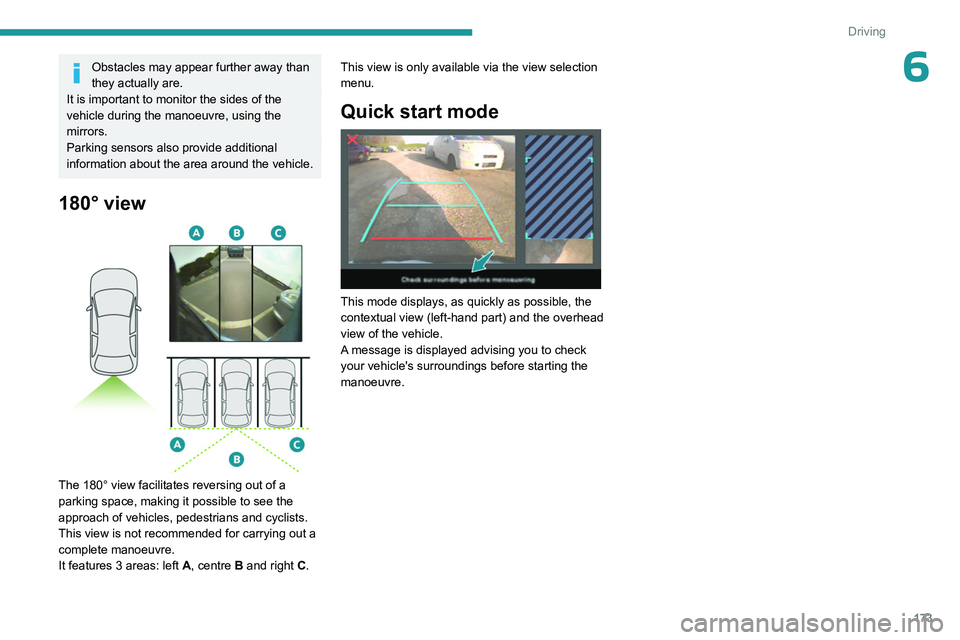
173
Driving
6Obstacles may appear further away than
they actually are.
It is important to monitor the sides of the
vehicle during the manoeuvre, using the
mirrors.
Parking sensors also provide additional
information about the area around the vehicle.
180° view
The 180° view facilitates reversing out of a
parking space, making it possible to see the
approach of vehicles, pedestrians and cyclists.
This view is not recommended for carrying out a
complete manoeuvre.
It features 3 areas: left A, centre B and right C. This view is only available via the view selection
menu.
Quick start mode
This mode displays, as quickly as possible, the
contextual view (left-hand part) and the overhead
view of the vehicle.
A message is displayed advising you to check
your vehicle's surroundings before starting the
manoeuvre.
Page 202 of 324
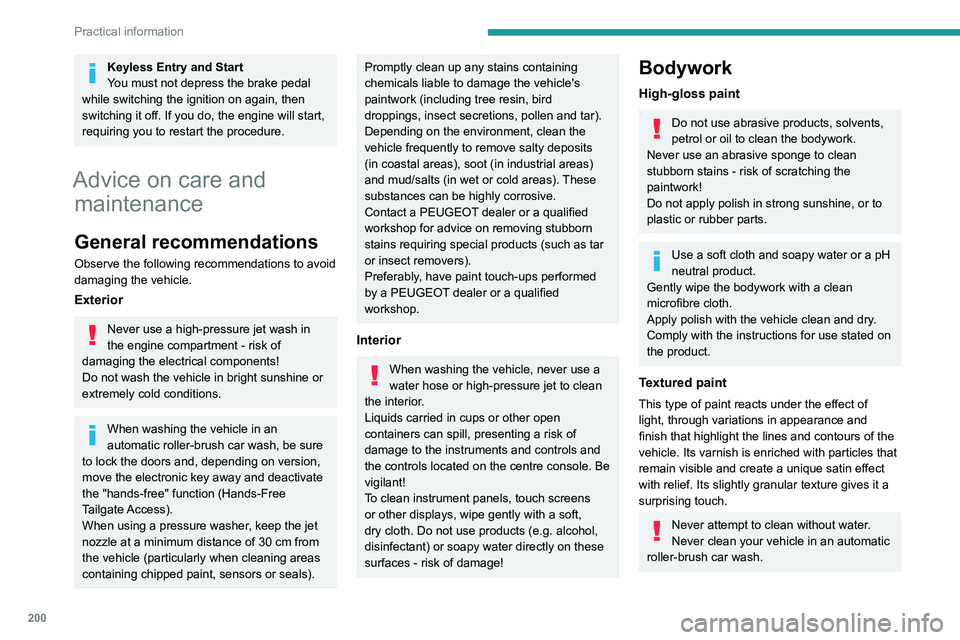
200
Practical information
Keyless Entry and Start
You must not depress the brake pedal
while switching the ignition on again, then
switching it off. If you do, the engine will start,
requiring you to restart the procedure.
Advice on care and maintenance
General recommendations
Observe the following recommendations to avoid
damaging the vehicle.
Exterior
Never use a high-pressure jet wash in
the engine compartment - risk of
damaging the electrical components!
Do not wash the vehicle in bright sunshine or
extremely cold conditions.
When washing the vehicle in an
automatic roller-brush car wash, be sure
to lock the doors and, depending on version,
move the electronic key away and deactivate
the "hands-free" function (Hands-Free
Tailgate Access).
When using a pressure washer, keep the jet
nozzle at a minimum distance of 30 cm from
the vehicle (particularly when cleaning areas
containing chipped paint, sensors or seals).
Promptly clean up any stains containing
chemicals liable to damage the vehicle's
paintwork (including tree resin, bird
droppings, insect secretions, pollen and tar).
Depending on the environment, clean the
vehicle frequently to remove salty deposits
(in coastal areas), soot (in industrial areas)
and mud/salts (in wet or cold areas). These
substances can be highly corrosive.
Contact a PEUGEOT dealer or a qualified
workshop for advice on removing stubborn
stains requiring special products (such as tar
or insect removers).
Preferably, have paint touch-ups performed
by a PEUGEOT dealer or a qualified
workshop.
Interior
When washing the vehicle, never use a
water hose or high-pressure jet to clean
the interior.
Liquids carried in cups or other open
containers can spill, presenting a risk of
damage to the instruments and controls and
the controls located on the centre console. Be
vigilant!
To clean instrument panels, touch screens
or other displays, wipe gently with a soft,
dry cloth. Do not use products (e.g. alcohol,
disinfectant) or soapy water directly on these
surfaces - risk of damage!
Bodywork
High-gloss paint
Do not use abrasive products, solvents,
petrol or oil to clean the bodywork.
Never use an abrasive sponge to clean
stubborn stains - risk of scratching the
paintwork!
Do not apply polish in strong sunshine, or to
plastic or rubber parts.
Use a soft cloth and soapy water or a pH
neutral product.
Gently wipe the bodywork with a clean
microfibre cloth.
Apply polish with the vehicle clean and dry.
Comply with the instructions for use stated on
the product.
Textured paint
This type of paint reacts under the effect of
light, through variations in appearance and
finish that highlight the lines and contours of the
vehicle. Its varnish is enriched with particles that
remain visible and create a unique satin effect
with relief. Its slightly granular texture gives it a
surprising touch.
Never attempt to clean without water.
Never clean your vehicle in an automatic
roller-brush car wash.
Page 213 of 324
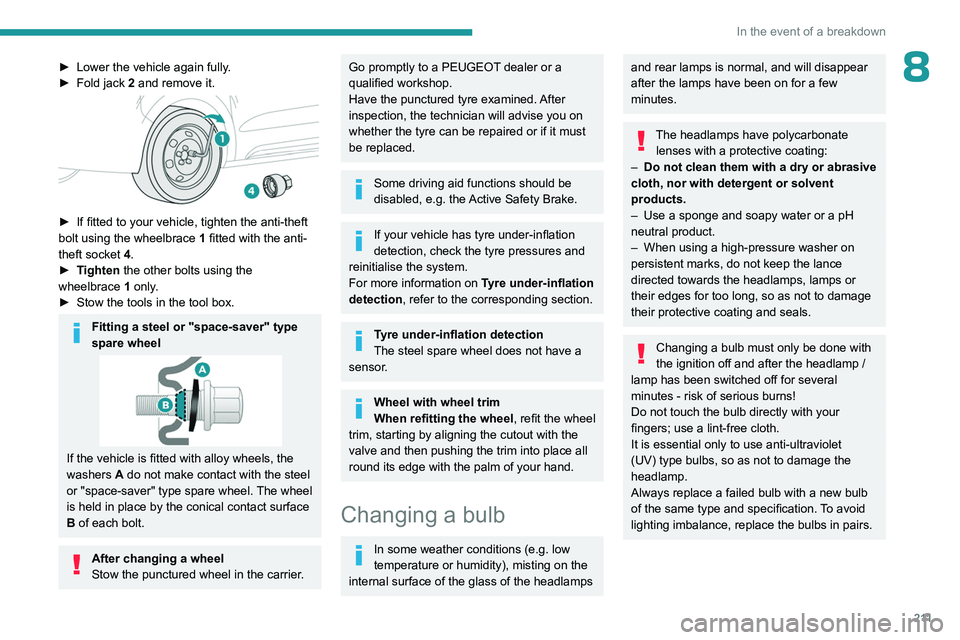
2 11
In the event of a breakdown
8► Lower the vehicle again fully.
► Fold jack 2 and remove it.
► If fitted to your vehicle, tighten the anti-theft
bolt using the wheelbrace 1 fitted with the anti-
theft socket
4.
►
T
ighten the other bolts using the
wheelbrace
1
only.
►
Stow the tools in the tool box.
Fitting a steel or "space-saver" type
spare wheel
If the vehicle is fitted with alloy wheels, the
washers A do not make contact with the steel
or "space-saver" type spare wheel. The wheel
is held in place by the conical contact surface
B of each bolt.
After changing a wheel
Stow the punctured wheel in the carrier.
Go promptly to a PEUGEOT dealer or a
qualified workshop.
Have the punctured tyre examined. After
inspection, the technician will advise you on
whether the tyre can be repaired or if it must
be replaced.
Some driving aid functions should be
disabled, e.g. the Active Safety Brake.
If your vehicle has tyre under-inflation
detection, check the tyre pressures and
reinitialise the system.
For more information on Tyre under-inflation
detection, refer to the corresponding section.
Tyre under-inflation detection
The steel spare wheel does not have a
sensor.
Wheel with wheel trim
When refitting the wheel, refit the wheel
trim, starting by aligning the cutout with the
valve and then pushing the trim into place all
round its edge with the palm of your hand.
Changing a bulb
In some weather conditions (e.g. low
temperature or humidity), misting on the
internal surface of the glass of the headlamps
and rear lamps is normal, and will disappear
after the lamps have been on for a few
minutes.
The headlamps have polycarbonate lenses with a protective coating:
–
Do not clean them with a dry or abrasive
cloth, nor with detergent or solvent
products.
–
Use a sponge and soapy water or a pH
neutral product.
–
When using a high-pressure washer on
persistent marks, do not keep the lance
directed towards the headlamps, lamps or
their edges for too long, so as not to damage
their protective coating and seals.
Changing a bulb must only be done with
the ignition off and after the headlamp /
lamp has been switched off for several
minutes - risk of serious burns!
Do not touch the bulb directly with your
fingers; use a lint-free cloth.
It is essential only to use anti-ultraviolet
(UV) type bulbs, so as not to damage the
headlamp.
Always replace a failed bulb with a new bulb
of the same type and specification. To avoid
lighting imbalance, replace the bulbs in pairs.
Page 287 of 324
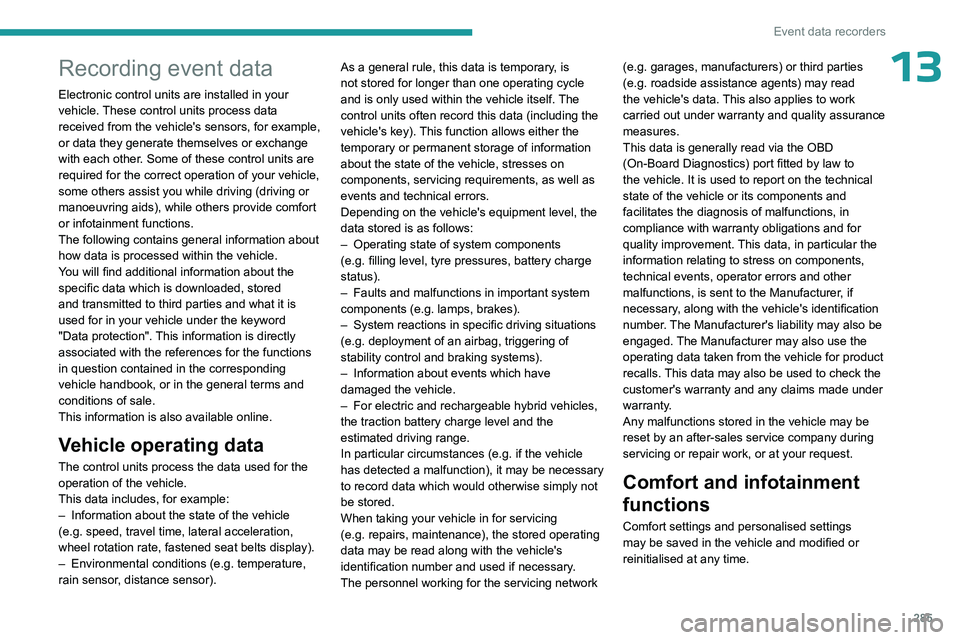
285
Event data recorders
13Recording event data
Electronic control units are installed in your
vehicle. These control units process data
received from the vehicle's sensors, for example,
or data they generate themselves or exchange
with each other. Some of these control units are
required for the correct operation of your vehicle,
some others assist you while driving (driving or
manoeuvring aids), while others provide comfort
or infotainment functions.
The following contains general information about
how data is processed within the vehicle.
You will find additional information about the
specific data which is downloaded, stored
and transmitted to third parties and what it is
used for in your vehicle under the keyword
"Data protection". This information is directly
associated with the references for the functions
in question contained in the corresponding
vehicle handbook, or in the general terms and
conditions of sale.
This information is also available online.
Vehicle operating data
The control units process the data used for the
operation of the vehicle.
This data includes, for example:
–
Information about the state of the vehicle
(e.g.
speed, travel time, lateral acceleration,
wheel rotation rate, fastened seat belts display).
–
Environmental conditions (e.g.
temperature,
rain sensor, distance sensor). As a general rule, this data is temporary, is
not stored for longer than one operating cycle
and is only used within the vehicle itself. The
control units often record this data (including the
vehicle's key). This function allows either the
temporary or permanent storage of information
about the state of the vehicle, stresses on
components, servicing requirements, as well as
events and technical errors.
Depending on the vehicle's equipment level, the
data stored is as follows:
–
Operating state of system components
(e.g.
filling level, tyre pressures, battery charge
status).
–
Faults and malfunctions in important system
components (e.g.
lamps, brakes).
–
System reactions in specific driving situations
(e.g.
deployment of an airbag, triggering of
stability control and braking systems).
–
Information about events which have
damaged the vehicle.
–
For electric and rechargeable hybrid vehicles,
the traction battery charge level and the
estimated driving range.
In particular circumstances (e.g.
if the vehicle
has detected a malfunction), it may be necessary
to record data which would otherwise simply not
be stored.
When taking your vehicle in for servicing
(e.g.
repairs, maintenance), the stored operating
data may be read along with the vehicle's
identification number and used if necessary.
The personnel working for the servicing network (e.g.
garages, manufacturers) or third parties
(e.g. roadside assistance agents) may read
the vehicle's data. This also applies to work
carried out under warranty and quality assurance
measures.
This data is generally read via the OBD
(On-Board Diagnostics) port fitted by law to
the vehicle. It is used to report on the technical
state of the vehicle or its components and
facilitates the diagnosis of malfunctions, in
compliance with warranty obligations and for
quality improvement. This data, in particular the
information relating to stress on components,
technical events, operator errors and other
malfunctions, is sent to the Manufacturer, if
necessary, along with the vehicle's identification
number. The Manufacturer's liability may also be
engaged. The Manufacturer may also use the
operating data taken from the vehicle for product
recalls. This data may also be used to check the
customer's warranty and any claims made under
warranty.
Any malfunctions stored in the vehicle may be
reset by an after-sales service company during
servicing or repair work, or at your request.
Comfort and infotainment
functions
Comfort settings and personalised settings
may be saved in the vehicle and modified or
reinitialised at any time.
Page 290 of 324
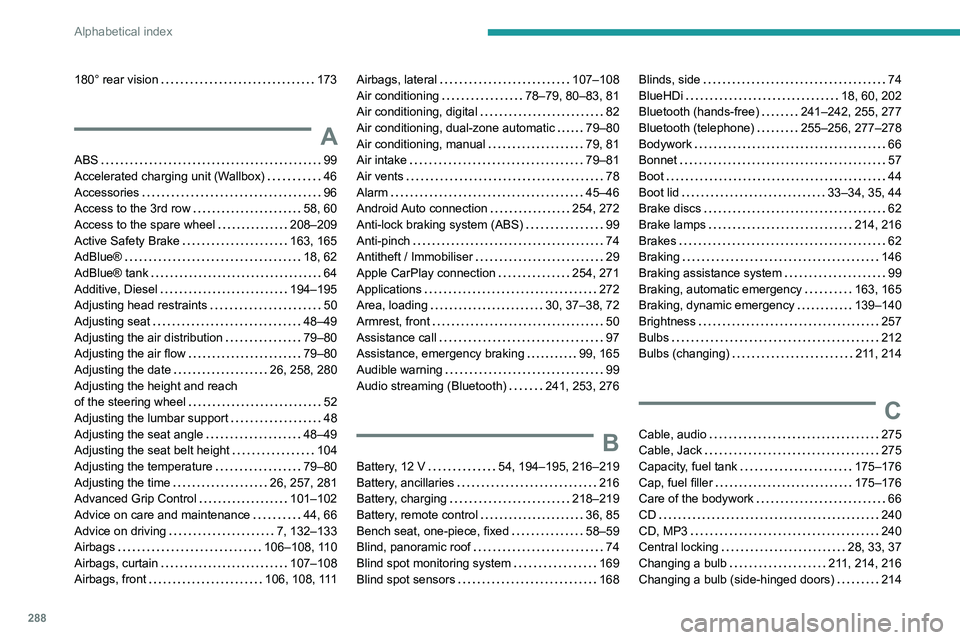
288
Alphabetical index
180° rear vision 173
A
ABS 99
Accelerated charging unit (Wallbox)
46
Accessories
96
Access to the 3rd row
58, 60
Access to the spare wheel
208–209
Active Safety Brake
163, 165
AdBlue®
18, 62
AdBlue® tank
64
Additive, Diesel
194–195
Adjusting head restraints
50
Adjusting seat
48–49
Adjusting the air distribution
79–80
Adjusting the air flow
79–80
Adjusting the date
26, 258, 280
Adjusting the height and reach
of the steering wheel
52
Adjusting the lumbar support
48
Adjusting the seat angle
48–49
Adjusting the seat belt height
104
Adjusting the temperature
79–80
Adjusting the time
26, 257, 281
Advanced Grip Control
101–102
Advice on care and maintenance
44, 66
Advice on driving
7, 132–133
Airbags
106–108, 110
Airbags, curtain
107–108
Airbags, front
106, 108, 111
Airbags, lateral 107–108
Air conditioning
78–79, 80–83, 81
Air conditioning, digital
82
Air conditioning, dual-zone automatic
79–80
Air conditioning, manual
79, 81
Air intake
79–81
Air vents
78
Alarm
45–46
Android Auto connection
254, 272
Anti-lock braking system (ABS)
99
Anti-pinch
74
Antitheft / Immobiliser
29
Apple CarPlay connection
254, 271
Applications
272
Area, loading
30, 37–38, 72
Armrest, front
50
Assistance call
97
Assistance, emergency braking
99, 165
Audible warning
99
Audio streaming (Bluetooth)
241, 253, 276
B
Battery, 12 V 54, 194–195, 216–219
Battery, ancillaries
216
Battery, charging
218–219
Battery, remote control
36, 85
Bench seat, one-piece, fixed
58–59
Blind, panoramic roof
74
Blind spot monitoring system
169
Blind spot sensors
168
Blinds, side 74
BlueHDi
18, 60, 202
Bluetooth (hands-free)
241–242, 255, 277
Bluetooth (telephone)
255–256, 277–278
Bodywork
66
Bonnet
57
Boot
44
Boot lid
33–34, 35, 44
Brake discs
62
Brake lamps
214, 216
Brakes
62
Braking
146
Braking assistance system
99
Braking, automatic emergency
163, 165
Braking, dynamic emergency
139–140
Brightness
257
Bulbs
212
Bulbs (changing)
211, 214
C
Cable, audio 275
Cable, Jack
275
Capacity, fuel tank
175–176
Cap, fuel filler
175–176
Care of the bodywork
66
CD
240
CD, MP3
240
Central locking
28, 33, 37
Changing a bulb
211, 214, 216
Changing a bulb (side-hinged doors)
214
Page 294 of 324
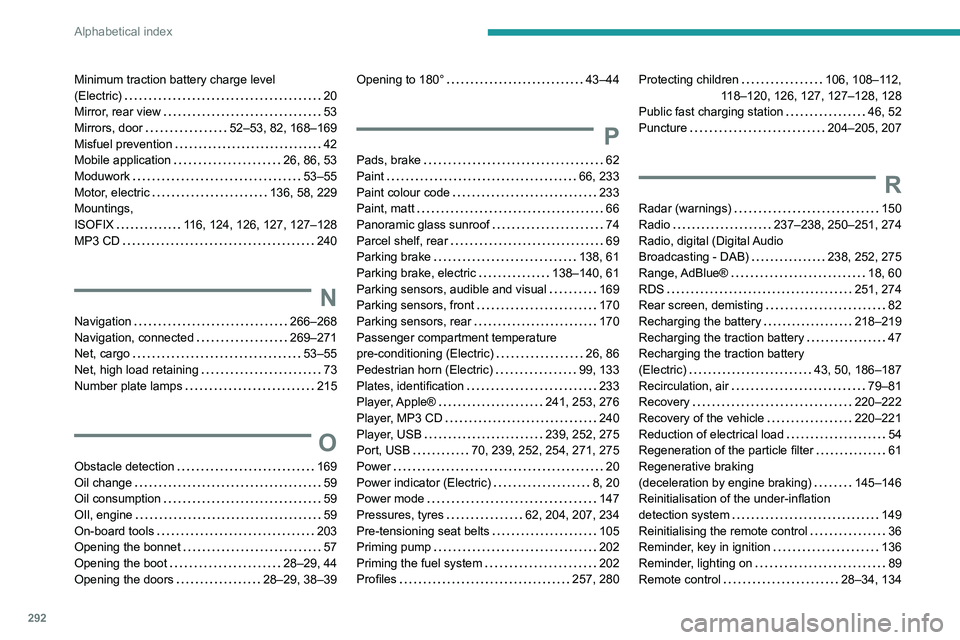
292
Alphabetical index
Minimum traction battery charge level
(Electric)
20
Mirror, rear view
53
Mirrors, door
52–53, 82, 168–169
Misfuel prevention
42
Mobile application
26, 86, 53
Moduwork
53–55
Motor, electric
136, 58, 229
Mountings,
ISOFIX
116, 124, 126, 127, 127–128
MP3 CD
240
N
Navigation 266–268
Navigation, connected
269–271
Net, cargo
53–55
Net, high load retaining
73
Number plate lamps
215
O
Obstacle detection 169
Oil change
59
Oil consumption
59
OIl, engine
59
On-board tools
203
Opening the bonnet
57
Opening the boot
28–29, 44
Opening the doors
28–29, 38–39
Opening to 180° 43–44
P
Pads, brake 62
Paint
66, 233
Paint colour code
233
Paint, matt
66
Panoramic glass sunroof
74
Parcel shelf, rear
69
Parking brake
138, 61
Parking brake, electric
138–140, 61
Parking sensors, audible and visual
169
Parking sensors, front
170
Parking sensors, rear
170
Passenger compartment temperature
pre-conditioning (Electric)
26, 86
Pedestrian horn (Electric)
99, 133
Plates, identification
233
Player, Apple®
241, 253, 276
Player, MP3 CD
240
Player, USB
239, 252, 275
Port, USB
70, 239, 252, 254, 271, 275
Power
20
Power indicator (Electric)
8, 20
Power mode
147
Pressures, tyres
62, 204, 207, 234
Pre-tensioning seat belts
105
Priming pump
202
Priming the fuel system
202
Profiles
257, 280
Protecting children 106, 108–112,
118–120, 126, 127, 127–128, 128
Public fast charging station
46, 52
Puncture
204–205, 207
R
Radar (warnings) 150
Radio
237–238, 250–251, 274
Radio, digital (Digital Audio
Broadcasting - DAB)
238, 252, 275
Range, AdBlue®
18, 60
RDS
251, 274
Rear screen, demisting
82
Recharging the battery
218–219
Recharging the traction battery
47
Recharging the traction battery
(Electric)
43, 50, 186–187
Recirculation, air
79–81
Recovery
220–222
Recovery of the vehicle
220–221
Reduction of electrical load
54
Regeneration of the particle filter
61
Regenerative braking
(deceleration by engine braking)
145–146
Reinitialisation of the under-inflation
detection system
149
Reinitialising the remote control
36
Reminder, key in ignition
136
Reminder, lighting on
89
Remote control
28–34, 134
Page 295 of 324
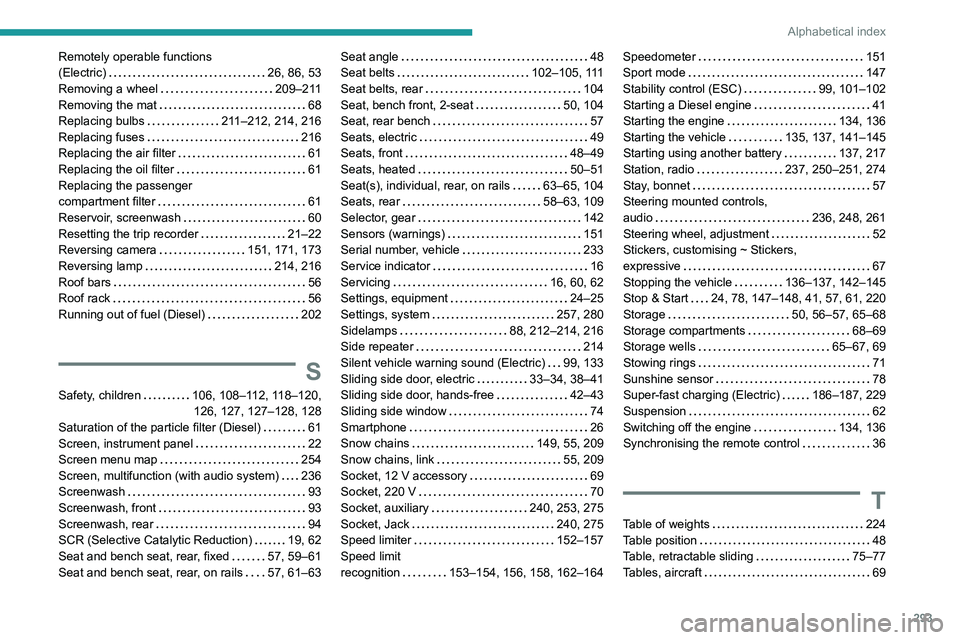
293
Alphabetical index
Remotely operable functions
(Electric)
26, 86, 53
Removing a wheel
209–211
Removing the mat
68
Replacing bulbs
211–212, 214, 216
Replacing fuses
216
Replacing the air filter
61
Replacing the oil filter
61
Replacing the passenger
compartment filter
61
Reservoir, screenwash
60
Resetting the trip recorder
21–22
Reversing camera
151, 171, 173
Reversing lamp
214, 216
Roof bars
56
Roof rack
56
Running out of fuel (Diesel)
202
S
Safety, children 106, 108–112, 118–120,
126, 127, 127–128, 128
Saturation of the particle filter (Diesel)
61
Screen, instrument panel
22
Screen menu map
254
Screen, multifunction (with audio system)
236
Screenwash
93
Screenwash, front
93
Screenwash, rear
94
SCR (Selective Catalytic Reduction)
19, 62
Seat and bench seat, rear, fixed
57, 59–61
Seat and bench seat, rear, on rails
57, 61–63
Seat angle 48
Seat belts
102–105, 111
Seat belts, rear
104
Seat, bench front, 2-seat
50, 104
Seat, rear bench
57
Seats, electric
49
Seats, front
48–49
Seats, heated
50–51
Seat(s), individual, rear, on rails
63–65, 104
Seats, rear
58–63, 109
Selector, gear
142
Sensors (warnings)
151
Serial number, vehicle
233
Service indicator
16
Servicing
16, 60, 62
Settings, equipment
24–25
Settings, system
257, 280
Sidelamps
88, 212–214, 216
Side repeater
214
Silent vehicle warning sound (Electric)
99, 133
Sliding side door, electric
33–34, 38–41
Sliding side door, hands-free
42–43
Sliding side window
74
Smartphone
26
Snow chains
149, 55, 209
Snow chains, link
55, 209
Socket, 12 V accessory
69
Socket, 220 V
70
Socket, auxiliary
240, 253, 275
Socket, Jack
240, 275
Speed limiter
152–157
Speed limit
recognition
153–154, 156, 158, 162–164Speedometer 151
Sport mode
147
Stability control (ESC)
99, 101–102
Starting a Diesel engine
41
Starting the engine
134, 136
Starting the vehicle
135, 137, 141–145
Starting using another battery
137, 217
Station, radio
237, 250–251, 274
Stay, bonnet
57
Steering mounted controls,
audio
236, 248, 261
Steering wheel, adjustment
52
Stickers, customising ~ Stickers,
expressive
67
Stopping the vehicle
136–137, 142–145
Stop & Start
24, 78, 147–148, 41, 57, 61, 220
Storage
50, 56–57, 65–68
Storage compartments
68–69
Storage wells
65–67, 69
Stowing rings
71
Sunshine sensor
78
Super-fast charging (Electric)
186–187, 229
Suspension
62
Switching off the engine
134, 136
Synchronising the remote control
36
T
Table of weights 224
Table position
48
Table, retractable sliding
75–77
Tables, aircraft
69